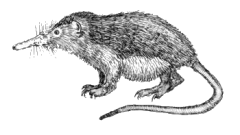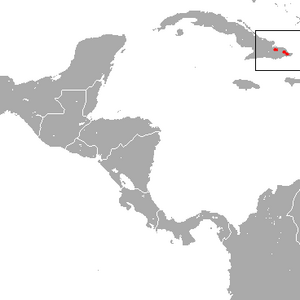Cuban Solenodon facts for kids
Quick facts for kids Cuban Solenodon |
|
|---|---|
 |
|
| Conservation status | |
| Scientific classification | |
| Kingdom: | |
| Phylum: | |
| Class: | |
| Order: | |
| Family: | |
| Genus: | |
| Species: |
S. cubanus
|
| Binomial name | |
| Solenodon cubanus Peters, 1861
|
|
 |
|
| Cuban Solenodon range | |
The Cuban Solenodon or Almiqui (Solenodon cubanus), is a very special type of mammal that lives only in Cuba. It's part of a small group of animals called soricomorphs, which are like shrews but with some unique features. This animal is related to another similar species, the Hispaniolan Solenodon, which lives on the island of Hispaniola.
One of the most amazing things about the Cuban Solenodon is that its saliva is venomous! This means it can deliver a mild poison through its bite, which is very rare for a mammal. Scientists first discovered this interesting creature in 1861, thanks to a German naturalist named Wilhelm Peters.
Contents
What is a Solenodon?
Solenodons are ancient mammals that have been around for millions of years. They look a bit like a large shrew or a small opossum, with a long snout, small eyes, and a scaly tail. There are only two types of solenodons left in the world: the Cuban Solenodon and the Hispaniolan Solenodon. Both are quite rare and special.
These animals are mostly active at night, which means they are nocturnal. They use their excellent sense of smell and long snouts to find food in the dark. Their unique features make them very important for scientists studying how mammals have evolved over time.
Where Do They Live?
The Cuban Solenodon is endemic to Cuba. This means it can only be found naturally in Cuba and nowhere else in the world. They prefer to live in forests, especially those with dense undergrowth and rocky areas. These habitats provide good places for them to hide, hunt, and build their homes.
They often live in burrows they dig themselves, or they might use natural shelters like hollow logs or rock crevices. Their habitat is very important for their survival, and protecting these areas helps keep them safe.
What Do They Eat?
Cuban Solenodons are insectivores, meaning their main diet consists of insects. They love to eat large insects like crickets, beetles, and cockroaches. But they don't stop there! They also enjoy worms, snails, and even small lizards or frogs.
Their long, flexible snout is perfect for sniffing out prey hidden in the soil or under leaves. They use their strong claws to dig and uncover their next meal. Their venomous bite helps them to quickly overpower their prey.
Special Features
The Cuban Solenodon has several unique features that make it stand out:
- Venomous Bite: As mentioned, it's one of the very few venomous mammals. The venom helps them to stun or kill their prey.
- Long Snout: Their snout is very flexible and helps them explore cracks and crevices for food.
- Strong Claws: They have powerful claws on their front feet, which are great for digging burrows and searching for insects.
- Small Eyes: Since they are nocturnal, their eyesight isn't their strongest sense. They rely more on their hearing and sense of smell.
Conservation Status
Sadly, the Cuban Solenodon is an endangered animal. This means there are not many of them left in the wild, and they face a high risk of disappearing forever. Their biggest threats include:
- Habitat Loss: Forests where they live are being cut down for farming or development.
- Predators: Animals like cats, dogs, and mongooses, which were brought to Cuba by humans, hunt solenodons.
- Small Population: Because there are so few of them, it's harder for them to recover from threats.
Many people are working hard to protect the Cuban Solenodon and its habitat. Conservation efforts include protecting their forest homes and educating people about these amazing creatures.
Discovery and History
The Cuban Solenodon was first described by Wilhelm Peters, a German zoologist, in 1861. He was the first to formally identify and name the species for science. For many years, scientists thought this animal might be extinct because it was so rarely seen.
However, in the 1970s, some individuals were rediscovered, giving hope for their survival. Today, while still rare, they are known to exist in certain parts of Cuba, reminding us of the hidden wonders of the natural world.
Images for kids
See also
 In Spanish: Solenodon cubanus para niños
In Spanish: Solenodon cubanus para niños



